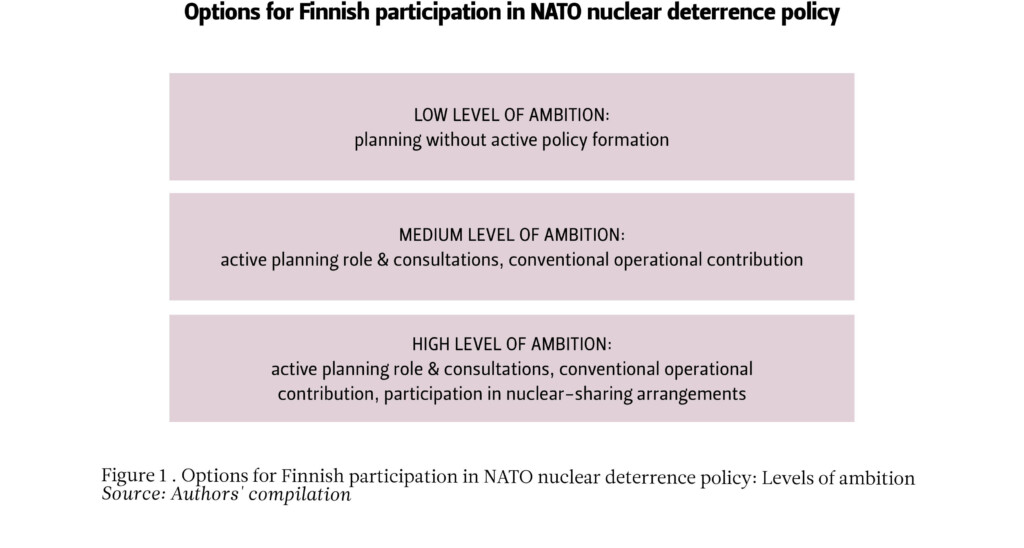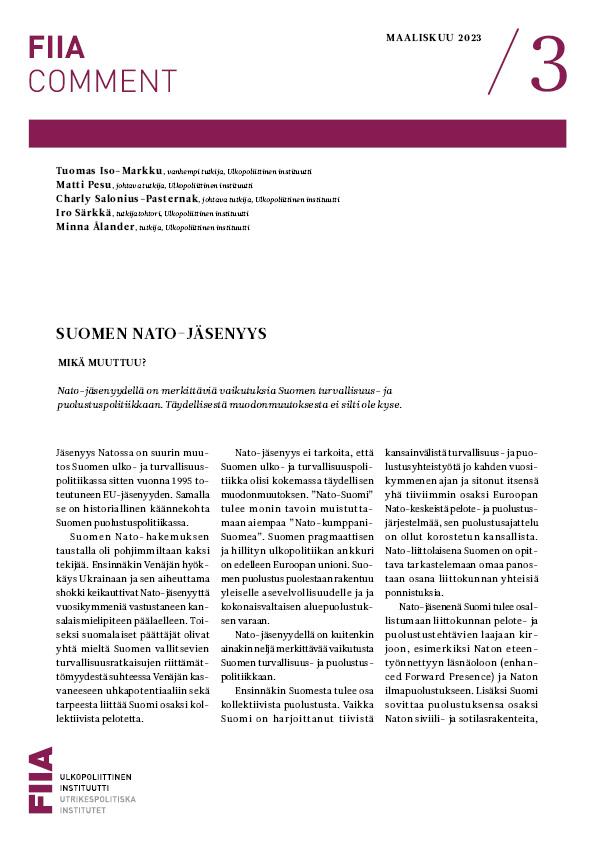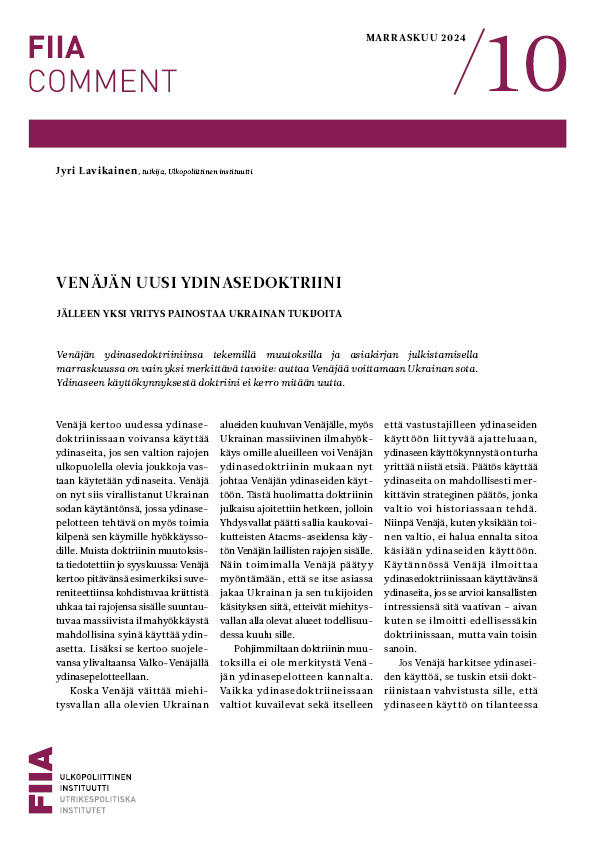Yksi keskeisistä syistä Suomen Nato-jäsenyyshakemukselle oli huoli mahdollisesta alttiudesta Venäjän ydinasepainostukselle. Ydinasepelotteen suojaan hakeutuminen nähtiin välttämättömänä Suomen turvallisuuden maksimoimiseksi.
Suomalainen poliittinen kenttä suhtautuu jokseenkin sallivasti siihen, että Suomi osallistuu Naton ydinasepolitiikkaan. Ydinasepelotteesta voi kuitenkin tulla poliittisen debatin aihe, kun Suomen Nato-politiikka hiljalleen kehittyy.
Suomi voi osallistua Naton ydinasepolitiikkaan usealla eri tavalla. Mahdollisuudet vaihtelevat suppeammasta passiivisesta strategiasta kunnianhimoisempiin aktiivisiin lähestymistapoihin.
Suomen pitkään jatkunut tuki ydinsulkusopimukselle luonnehtinee jatkossakin Suomen ydinaseriisuntapolitiikkaa. Vaikka aika ei ole tällä hetkellä kypsä uusille asevalvonta-aloitteille, Suomella on intressi edistää Naton toimia ydinasevalvonnan, aseriisunnan ja asesulun saralla.
Introduction
Finland’s bid for NATO membership in May 2022 was triggered by several factors, all related to Russia’s full-scale invasion of Ukraine. One of the causes was the abrupt realization that as a non-allied country not covered by extended nuclear deterrence, Finland might be susceptible to Russian strategic intimidation.[1]
Indeed, Russia’s full-scale invasion duly resulted in a remarkable transformation in the Finnish views on nuclear deterrence. Traditionally, Finland has approached nuclear weapons from the perspective of regional stability, arms control and non-proliferation. Now – as a member of a nuclear alliance – it is expected to support and even contribute to NATO’s nuclear deterrence policy. However, it is important to recognize that nuclear deterrence and arms control are not mutually exclusive efforts. In fact, NATO’s new strategic concept clearly states how both nuclear deterrence and arms control maintain strategic stability.
The Finnish role in NATO’s nuclear deterrence policy is a pertinent question. First, NATO’s nuclear dimension has attracted considerable public attention in Finland. It is also a policy area in which the Finnish political field is not unanimous. Currently, Finnish parties are solidly behind NATO membership, but a faction of politicians and civil society actors will likely want to keep Finland at arm’s length from the alliance’s nuclear activities. Second, given Finland’s history as a non-allied nation strongly in favour of nuclear arms control and non-proliferation, its allies will likely keep a close eye on Finland’s evolving approach and the way Helsinki deals with nuclear issues in international fora. The allied interest in Finnish nuclear views may be further magnified by its military capabilities and geographical proximity to Russian nuclear assets.
This Briefing Paper examines Finland’s role in and potential contribution to NATO’s nuclear deterrence policy as well as the domestic underpinnings of the evolving Finnish approach to nuclear deterrence. Furthermore, it sheds light on Finnish efforts to promote nuclear arms control, disarmament and non-proliferation and assesses what implications NATO membership has for these policies.
NATO’s dual-track approach on nuclear weapons
NATO’s dual-track approach to nuclear weapons includes its nuclear deterrence policy and forces on the one hand, and nuclear arms control, disarmament and non-proliferation on the other. Importantly, within the alliance, there is significant overlap between these efforts, both being part of the same bigger whole.
Nuclear deterrence policy and forces
Nuclear weapons have constituted a critical but varying dimension of NATO’s deterrence since the inception of the alliance. The end of the Cold War resulted in a dramatic decrease in the number and importance of nuclear weapons. The hiatus lasted for nearly three decades. The re-emergence of great-power rivalry has propelled nuclear deterrence back on the agenda of international security. In NATO, nuclear deterrence enjoys reinvigorated legitimacy.
NATO’s strategic concept from 2022 defines the core principles of the alliance’s nuclear doctrine as follows:
-
The fundamental purpose of NATO’s nuclear capability is to preserve peace, prevent coercion and deter aggression.
-
As long as nuclear weapons exist, NATO will remain a nuclear alliance.
-
The strategic nuclear forces of the alliance, particularly those of the US, are the supreme guarantee of the security of the alliance.
-
NATO’s deterrence and defence posture is based on an appropriate mix of nuclear, conventional and missile defence capabilities.
In terms of ongoing policy processes related to nuclear deterrence, the communique from the 2023 Vilnius Summit states that the alliance will continue to modernize its nuclear capability and update planning to increase the flexibility and adaptability of its nuclear forces. It also declares that NATO reaffirms the imperative to ensure the broadest possible participation by allies in NATO’s nuclear burden-sharing arrangements.
The key principles of NATO’s nuclear policy are established by all NATO Heads of State and Government. The development and implementation of NATO’s nuclear policy are the responsibility of the Nuclear Planning Group (NPG), which is a critical forum for nuclear consultation participated in by all the allies apart from France.
Another vital participatory element of NATO’s nuclear policy is nuclear sharing, in which certain allies host US forward-deployed nuclear weapons and offer dual-capable aircraft (DCA), which can be equipped with the American non-strategic nuclear weapons. Allies can also provide a broad array of conventional capabilities to support NATO’s nuclear mission through the Conventional Support for Nuclear Operations (CSNO) mechanism.
Allies also regularly practise nuclear operations. In 2023, NATO’s annual nuclear strike exercise Steadfast Noon involved 13 allies, contributing either dual-capable or conventional capabilities to the event. Furthermore, the alliance also reportedly arranges command post exercises simulating nuclear decision-making.[2]
Nuclear arms control, disarmament and non-proliferation
In addition to maintaining nuclear deterrence, NATO has a long-standing commitment to arms control, disarmament and non-proliferation. The seeds of this dual-track approach combining deterrence and dialogue were sown in the so-called Harmel report in 1967. The policy was duly put in practice at the turn of the 1980s when NATO decided to deploy American intermediate-range ballistic and cruise missiles in Europe. However, it leveraged the new missiles with progress in arms control negotiations with Moscow, which eventually led to the achievement of the Intermediate-Range Nuclear Forces Treaty (INF Treaty) in 1987.
The redux of great-power competition in the mid-2010s has severely eroded the established nuclear arms control regimes. Most notably, as a response to the Russian violation of the INF Treaty, the US withdrew from the agreement in 2019. In early 2023, Russia again announced that it would suspend its participation in the New START Treaty signed in 2010. The increasingly tripolar nuclear order, that is, the ongoing rise of China as a major nuclear power alongside the US and Russia, as well as the dramatically deteriorated bilateral relationship between Washington and Moscow make the emergence of new arms control treaties unlikely in the foreseeable future.
Despite the bleak situation, nuclear arms control, non-proliferation and disarmament remain on NATO’s agenda. The alliance not only views these efforts as a central element of strategic stability but also declares that its goal is to create the security environment for a world without nuclear weapons. The alliance sees the Non-Proliferation Treaty (NPT) as the cornerstone of global efforts to prevent the spread of nuclear weapons and achieve the goal of nuclear disarmament. NATO is also of the view that the Treaty on the Prohibition of Nuclear Weapons (TPNW) stands in opposition to its nuclear deterrence policy.
As an organization, NATO does not sign arms control treaties. Rather, it offers a platform for allied coordination, information sharing and consultations regarding arms control efforts. Several NATO committees and bodies oversee different aspects of NATO’s activities in the fields of arms control, disarmament and non-proliferation. The Arms Control, Disarmament and WMD Non-Proliferation Centre (ACDC) under the International Staff oversees the committees working with issues related to arms control, disarmament and non-proliferation. The North Atlantic Council provides the overall political guidance.
First track: Finland and NATO nuclear deterrence
The idea of deterrence is deeply ingrained in Finnish strategic culture. By sustaining significant military capabilities, Finland has sought to maintain a high threshold against military aggression. This deterrence-by-denial posture has been supplemented by a resilient society rejecting malign influencing by foreign powers. NATO membership introduces a new element to the Finnish deterrence mix: extended deterrence provided by allied nuclear forces. This creates a novel dimension for policymaking and options for the national contribution.
Assessment of domestic policy drivers
From the onset of Finland’s NATO bid, Finnish decision makers underscored that the country would not restrict the scope of its activities in the alliance. This approach is now cemented in the programme of Petteri Orpo’s government, which states that “Finland will participate fully in all NATO activities”. It also underscores that Finland will take part in “NATO’s missions and operations, international exercises, and committees and working groups, including the Nuclear Planning Group.”
Indeed, the defence minister of the previous government, Antti Kaikkonen, participated in the June 2023 meeting of the NPG. Finnish officials are also involved in the work of its subordinate bodies, such as the High-Level Group and the NPG Staff Group.
The domestic political environment has traditionally been a key determinant of how allies view nuclear deterrence. In Finland, the domestic landscape is rather permissive in terms of Finland’s participation in NATO’s nuclear deterrence policy. In May 2023, 43 percent of Finns were in favour of Finland taking part in NATO’s nuclear weapons exercises, whereas 30 percent opposed the idea. That said, in a different survey, most Finns – 77 percent altogether – were against the stationing of nuclear weapons in Finland. Sixty-one percent of the population also oppose allowing nuclear weapons to be transported through Finland’s territory.[3]
Finnish decision makers are rather supportive of Finland’s active participation in NATO’s nuclear deterrence policy. President Sauli Niinistö has explicitly stated that Finland will take part in the work of the NPG and join the alliance’s nuclear weapons exercises. Some surveys suggest that policymakers are sympathetic to Finland’s participation not only in nuclear planning but also in operational arrangements, such as the CSNO. However, the data also indicates that policymakers do not yet have strong views on the matter, which is likely a result of the novelty of the question.[4]
Despite the prevailing pragmatism, societal factions exist that are unsympathetic to active involvement in NATO’s nuclear deterrence policy. Certain NGO actors, mainly linked to the peace movement, have established a Nuclear Weapons Monitoring Group. Its report from May 2023 suggests that Finland should adopt a cautious approach regarding nuclear deterrence in general and NATO’s nuclear deterrence policy in particular.[5] Thus, given the political sensitivity of nuclear weapons, the nuclear dimension of Finnish NATO membership may become a bone of contention – in other words, a policy area in which there is no consensus. These tensions may become increasingly visible in the future as a response to developments in policy formation and the associated legislative work.
Interestingly, a legislative change concerning the Finnish Nuclear Energy Act is currently underway. The act prohibits the importation, manufacturing, possession and detonation of nuclear explosives in Finnish territory. Although the ongoing process is not related to nuclear weapons per se, Finnish security authorities and policymakers may want to reappraise the restrictions,[6] which will likely resonate negatively on the left side of the political spectrum.
Options for Finland’s contribution to NATO’s nuclear deterrence policy
The options for Finnish participation in NATO nuclear deterrence policy range from low to medium and high level of ambition,[7] which are illustrated in Figure 1.

The cautious alternative would merely entail participation in NATO’s nuclear planning without actively forming a national policy position or participating in operational activities.
A more ambitious, medium-level contribution would involve active work in NATO’s committees which prepare the alliance’s nuclear weapons policy. This would also include regular consultations with different allies, ranging from nuclear allies to members contributing dual-capable aircraft to NATO’s nuclear missions, for example. In addition to planning and consultations, Finland could also seek to host nuclear deterrence related meetings such as the alliance’s main nuclear policy event, the NATO Nuclear Policy Symposium. On the military side, medium-level ambition could entail offering conventional capabilities, such as fighter jets, to NATO’s nuclear missions. Finland’s role in NATO’s nuclear deterrence would then be practised in NATO’s annual nuclear strike exercise, Steadfast Noon.
A high-ambition approach would not only build on active participation in nuclear planning, consultations and operational activities but would also consider out-of-the-box alternatives such as certifying a handful of Finland’s future F-35s to carry nuclear weapons – an option entertained by some nuclear weapons experts.[8] In practice, a high-ambition Finland would seek to expand NATO’s current nuclear sharing arrangements, pursuing a distinctive national involvement in its nuclear efforts.
Considering these options and figuring out the best approach for Finland will take time. However, it is widely reckoned in Finland that Finnish national expertise on nuclear weapons and deterrence must be urgently improved. This desire predates NATO membership. Since 2018, various low-key initiatives have emerged within the government and broader national security community to strengthen the Finnish “nuclear IQ”, that is, the understanding of the political, military and technical aspects of nuclear weapons. Information received from the NPG and allied consultations will help Finland enhance its level of expertise.
In line with the agreed statements, NATO officials have welcomed the idea of Finland taking an active role in NATO’s nuclear deterrence policy, including participation in nuclear weapons exercises. That said, there are no signs of allied pressure on Finland. Quite the contrary: Finland’s allies likely wish that Helsinki would adopt a step-by-step approach whereby it would incrementally enhance its grasp of NATO nuclear deterrence policy. Such an effort is likely seen as desirable before Finland considers a more active involvement in NATO nuclear planning or operational activities such as nuclear exercises and the CSNO.
Second track: Finland and nuclear arms control
Historically, Helsinki’s approach to nuclear arms control and disarmament can be understood as a combination of liberalist and realist ideas. The realist dimension recognizes the focal role of the nuclear weapon states, especially the so-called Permanent 5 (P5), in arms control efforts. In the Finnish view, any meaningful progress in disarmament and arms control necessitates a consensus among these major powers possessing nuclear weapons.
These realist, great-power-centric tendencies are, however, supplemented by liberal undertones that highlight the moral and practical responsibility of the P5 states in managing strategic stability.[9] This ethos combining realist and liberalist tendencies will most likely characterize Finland’s stance towards nuclear arms control and non-proliferation in NATO as well. More precisely, Finland’s nuclear arms control profile in NATO will likely be built on three key premises:
-
Staunch support for the NPT regime
-
Emphasis on timely arms control initiatives as a counterweight to deterrence
-
Utilization of arms control to promote Finland’s immediate security interests.
First, Finland has a long historical affinity with the NPT and the broader arms control regime around it. During the Cold War era, Finland made several regional nuclear arms control initiatives and provided technical expertise related to the NPT regime and the Comprehensive Nuclear-Test-Ban Treaty (CTBT). Other historical examples include chairing the group of sponsors supporting the joint US-Soviet Union draft proposal for the NPT at the UN in the spring of 1968. Most importantly, Finnish decision makers made sure Finland was among the first countries to sign the NPT.[10]
More recent examples of Finland’s endeavours in the fora of non-proliferation diplomacy include facilitating the consultations on a weapons of mass destruction free zone in the Middle East in 2012–2014 and the role as chair of the first session of the Preparatory Committee of the 2026 NPT Review Conference (RevCon).
As an ally, Finland will likely continue to highlight the importance of the NPT as the anchor of the global nuclear order. It can also be expected to support certain “middle-ground” proposals, such as the Stockholm Initiative to Nuclear Disarmament, which aims to reinforce diplomatic efforts to implement the disarmament pledge provided by the P5 within the NPT framework. Furthermore, NATO allies are expected to support the view that NATO’s nuclear sharing arrangements and the practice of extended nuclear deterrence are in line with the intention and letter of Articles I and II of the NPT. The active defence of the allied positions in this matter is a novel feature in Finnish arms control policy.
Following the long-standing pragmatist tenets emphasizing the NPT and the responsibility of the nuclear weapons states, Finland decided not to participate in the negotiations that led to the Treaty on the Prohibition of Nuclear Weapons (TPNW) at the UN in 2017.[11] Although Finland did participate in the first meeting of the TPNW state parties in June 2022 as an observer, the current government has decided not to observe any further TPNW state party meetings – a demonstration of support to the political stance taken by NATO on the matter.[12] This will likely be met with criticism from the left side of the Finnish political spectrum, questioning the government’s adherence to gradual nuclear disarmament, especially if NATO members such as Norway, Netherlands, Belgium and Germany continue to participate in TPNW meetings as observers.
Second, after a short period of “nuclear learning”, Finland is likely to participate actively in NATO’s internal work on nuclear arms control in its various committees and advisory groups. Moreover, the long tradition of civil-military cooperation in the field of chemical, biological, radiological and nuclear defence (CBRN), together with the high level of CBRN capabilities of the Finnish Defence Forces, gives Helsinki another possible avenue to further modernize its dual-track mindset within NATO.
Third, Finland also has more specific interests in contributing to the arms control policies within NATO. In its public statements, like in the one given at the 2022 NPT RevCon, Finland repeated its support to strategic dialogue between existing nuclear weapon states. It also emphasized the importance of achieving a global moratorium over developing new nuclear weapon systems although no unilateral concessions are expected by the NATO’s nuclear powers in this regard.
When it comes to Finland’s immediate security environment, Helsinki has an interest in keeping non-strategic nuclear weapons on the agenda of any arms control talks between the US and Russia. While the time is not currently ripe for new arms control proposals, the need to reinforce consensus among allies on the threat posed by Russia’s non-strategic nuclear weapon systems around the Baltic Sea Area and Northern Europe remains high.
Conclusion
On 4 April 2023, Finland joined a nuclear alliance. Deterrence provided by allied nuclear forces is a vital element of NATO’s deterrence mix. The alliance’s reliance on nuclear weapons is balanced by allied efforts to promote arms control, disarmament and non-proliferation. NATO’s approach to strategic stability is thus twofold: both nuclear deterrence and arms control are needed to maintain order in the international security environment.
Finland has had its idiosyncratic dual-track mindset for decades. Both conventional deterrence and arms control have long been on the agenda of Finnish national security policy. Finnish entry to a nuclear alliance forces Helsinki to recalibrate this outlook, which will likely be a relatively smooth but not entirely effortless process.
First, Finland must come up with a national approach to NATO nuclear deterrence policy. It has several options ranging from a cautious, low-ambition strategy to a high-ambition policy. Finland will likely adopt a step-by-step approach with a strong emphasis on enhancing the Finnish nuclear IQ. Its domestic environment is rather permissive towards seeking an active role.
Second, Finland’s historical affinity with the NPT should facilitate a seamless adaptation to NATO’s arms control efforts. That said, Finland may have to adjust its approach to the NPT as the alliance expects Finland to support its priorities, such as the legitimacy of extended nuclear deterrence and nuclear sharing arrangements. More generally, it might take some time to readjust the Finnish strategic thinking regarding the sources of strategic stability. Finland’s traditional approach to arms control and disarmament has focused on achieving arms reductions and military disengagement. Now the primary aim of arms control is not necessarily to promote disarmament or reductions but to avoid unnecessary escalatory dynamics which relate to the sustainment of a strong NATO deterrence posture. However, the alliance and Finland should be prepared if the environment one day becomes more conducive to arms control efforts.
Endnotes
[1] Pesu, Matti and Tuomas Iso-Markku (2022) “Finland as a NATO ally: First insights into Finnish alliance policy”. Finnish Foreign Policy Paper 9, December 2022, The Finnish Institute of International Affairs, https://fiia.fi/en/publication/finland-as-a-nato-ally.
[2] Durkalec, Jacek (2015) “Nuclear-Backed ‘Little Green Men’: Nuclear Messaging in the Ukraine Crisis”, Report, July 2015, Polish Institute of International Affairs, https://www.files.ethz.ch/isn/193514/Nuclear%20Backed%20%E2%80%9CLittle%20Green%20Men%E2%80%9D%20Nuclear%20Messaging%20in%20the%20Ukraine%20Crisis.pdf.
[3] Wass, Hanna, et al. (2023) “Turbovaihteella turvallisuutta: suomalaisten odotukset Nato-jäsenyydelle”, NATOpoll Policy Brief 1/2023, 6 July 2023, University of Helsinki, https://www.helsinki.fi/assets/drupal/2023-07/NATOpoll%20policy%20brief%201_2023.pdf; Harju, Jukka (2023) “Näin Nato-tukikohdat ja ydinaseet jakavat suomalaisia”, Helsingin Sanomat, 24 May 2023, https://www.hs.fi/kotimaa/art-2000009601593.html.
[4] Salonius-Pasternak, Charly (2023) “Kansanedustajien mielipiteitä Suomen turvallisuuspolitiikasta: Konsensus vahva, mutta lainsäätäjät myös uuden edessä”, FIIA Comment 11/2023, 24 October 2023, The Finnish Institute of International Affairs, https://fiia.fi/wp-content/uploads/2023/10/comment11_kansanedustajien-mielipiteita-suomen-turvallisuuspolitiikasta.pdf.
[5] The Nuclear Weapons Monitoring Group (2023) “Finland and the Challenges of Nuclear Weapons Policy”, Report of the Nuclear Weapons Monitoring Group, 17 May 2023, https://sites.google.com/view/ydinaseseuranta/ryhm%C3%A4n-raportit/eng-finland-and-the-challenges-of-nuclear-weapons-policy.
[6] This has been suggested by the former Minister of Defence Mikko Savola, for example. See Hakahuhta, Ari (2023) “Amerikkalaissotilaiden asema Suomessa herättää epäilyjä vasemmisto-oppositiossa”, Yle Uutiset, 17 August 2023, https://yle.fi/a/74-20045628.
[7] Alberque, William (2022) “Nuclear Deterrence 101”, Maanpuolustus 3/2022, https://www.maanpuolustus-lehti.fi/nuclear-deterrence-101/.
[8] Kuhn, Frank (2023) “Making Nuclear Sharing Credible Again: What the F-35 Means for NATO”, War on the Rocks, 14 September 2023, https://warontherocks.com/2023/09/making-nuclear-sharing-credible-again-what-the-f-35a-means-for-nato/.
[9] Juntunen, Tapio (2023) “Finland: From Curious Observer to Active Accommodator of the NPT Process”. In Neutral Europe and the Creation of the Nonproliferation Regime, 1958–1968, edited by Pascal Lottaz and Yoko Iwama. Abingdon: Routledge, 130–149.
[10] Paju, Petri (2020) “Finland and nuclear non-proliferation. Fifty years of implementing the Nuclear Non-Proliferation Treaty”, STUK-TR 34, October 2020, Radiation and Nuclear Safety Authority, https://www.julkari.fi/bitstream/handle/10024/140618/STUK_Finland_and_Nuclear_Non-Proliferation.pdf?sequence=1&isAllowed=y.
[11] Juntunen, Tapio (2018) “Harmaantuvaa pienvaltioliberalismia: Suomi, ydinaseiden kieltosopimus ja ulkopolitiikan koulukuntavaikutteet”. Kosmopolis 48 (4): 39–63, https://www.researchgate.net/publication/334769782_Harmaantuvaa_pienvaltioliberalismia_Suomi_ydinaseiden_kieltosopimus_ja_ulkopolitiikan_koulukuntavaikutteet.
[12] Ministry for Foreign Affairs of Finland, Ydinasekieltosopimuksen (Treaty on the Prohibition of Nuclear Weapons, TPNW) toinen osapuolikokous New Yorkissa 27.11.–1.12.2023. Unit for Arms Control, 4 October 2023, https://www.eduskunta.fi/FI/vaski/Liiteasiakirja/Documents/EDK-2023-AK-27424.pdf.









